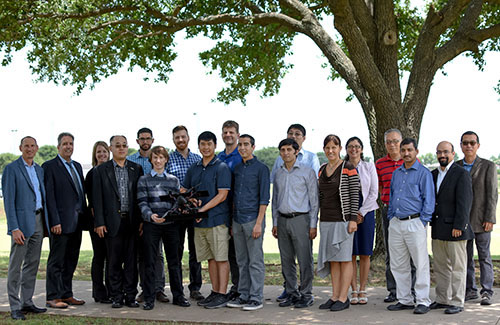|
|
|
|
 Research collaboration focuses on drones Research collaboration focuses on drones
The Army Research Laboratory VTD Vehicle Applied Research Division recently visited UNT's Discovery Park to discuss opportunities for joint research with the College of Engineering. The two teams dove deep into topics related to unmanned aircraft systems, or drones, and conducted tours of the college's labs and research facilities, including the Materials Research Facility, Additive Manufacturing Lab and other labs focused on drone communications, sensors, computing and circuit design. This visit comes as part of a rapidly growing partnership with the Army Research Laboratory aimed at connecting their research needs with university researchers.
|
|
|
|
|
|
| Leading UNT's additive manufacturing efforts |
|
Narendra Dahotre, Regents Professor of materials science and engineering at UNT, was named associate vice president for the Center for Agile and Adaptive Additive Manufacturing at UNT. In his new role, Dahotre will facilitate the expansion of the infrastructure and the resulting collaborations and research in the new center, which will lead to smart materials and environmentally friendly technologies while helping Texas develop a highly skilled workforce of engineers.
|
|
|
|
|
|
|
| Advancing biomedical research with computational chemistry |
|
G. Andrés Cisneros and his team at UNT's Center for Advanced Scientific Computing and Modeling (CASCaM) are using computers to look at how mutations of certain genes may be related to cancer. Cisneros has received $1.25 million from the National Institutes of Health and $250,000 from the National Science Foundation for his research. Cisneros' work could lead to important applications in the medical field, such as the development of diagnostic tools that look for biomarkers for certain cancers.
|
|
|
|
|
|
|
| Boosting biofuel research |
|
The U.S. Department of Energy recently announced a $64 million investment in university genomics research to develop crops for bioenergy. UNT will receive $2.3 million for a project led by the BioDiscovery Institute's Ana Paula Alonso and Kent Chapman focusing on the pennycress plant, which can be grown as a cash crop that fits perfectly between the growing seasons of corn and soybean. Blending oil from the pennycress with jet fuel can improve efficiencies and the impact on the environment — without affecting food supply.
|
|
|
|
|
|
|
|
| Understanding history of postpartum depression |
|
As a historian of health, medicine and modern U.S. politics, Rachel Louise Moran is delving into how society has defined and diagnosed postpartum depression, a disease that affects 1 in 9 U.S. women. Funded by a $162,619 grant from the National Science Foundation, Moran, an assistant professor in UNT's Department of History, will trace how postpartum depression during 1950-2000 has been talked about by a variety of groups, from the medical and religious spheres to politics and popular rhetoric.
|
|
|
|
|
|
|
| Discovering oak trees as natural urban air filters |
|
A research team led by Alexandra Ponette-González, associate professor in UNT's Department of Geography and the Environment, and graduate student Jenna Rindy has discovered that two oak tree species, widespread across the southern U.S., remove black carbon from the urban atmosphere. Their findings may offer a natural way to improve climate and air quality. Using data on black carbon emissions factors, fuel consumption and tree leaf areas in Denton, the team estimated that post oak and live oak trees potentially capture about 32% of the city's yearly black carbon vehicle emissions.
|
|
|
|
|
|